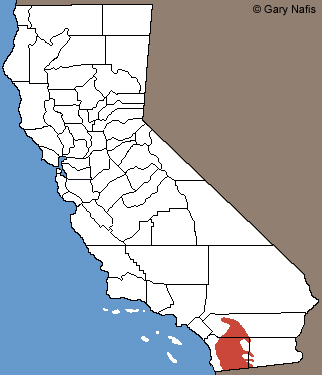|
 |
| Light phase adult, Imperial County desert |
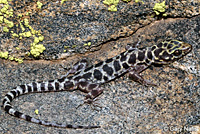 |
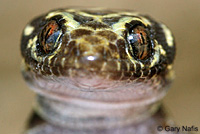 |
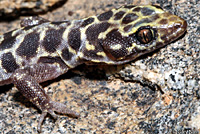 |
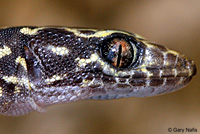 |
| Dark phase adult, Riverside County. |
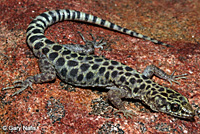 |
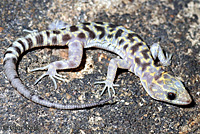 |
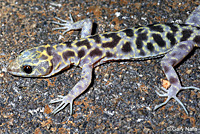 |
 |
| Adult, Riverside County |
Light-phase adult, photographed while active at night, coastal San Diego County. |
 |
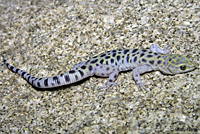 |
 |
 |
| Light phase adult, photographed while active at night on the face of a massive boulder, Imperial County. |
Adult on rock at night, Imperial County |
Adult, Imperial County |
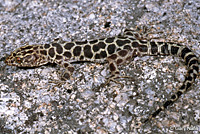 |
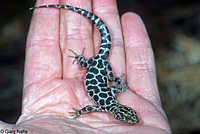 |
 |
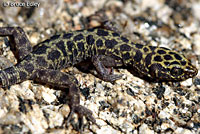 |
| Dark phase adult, 7,500 ft. San Jacinto Mountains, Riverside County, found hiding under a rock during daylight. |
Dark phase adult, San Diego County
© Bruce Edley |
 |
 |
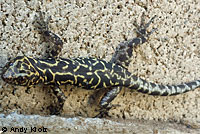 |
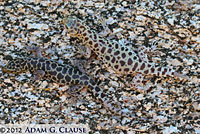 |
| Adult, San Diego County, (captured and handled under state Scientific Collecting Permit and released at point of capture.) © Adam Clause |
Adult, San Diego County
© Andy Klotz |
Dark and light phase adults,
San Diego County. © Adam G. Clause
|
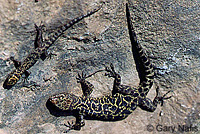 |
 |
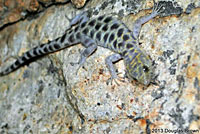 |
 |
Dark phase adult and Juvenile, found hiding together under a loose rock slab
during daylight, near El Cajon, coastal San Diego County. |
Adult from near Poway, San Diego County © Douglas Brown |
Adult from near Poway, San Diego County © Douglas Brown |
Adult from near Poway, San Diego County © Douglas Brown |
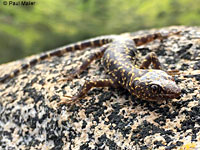 |
 |
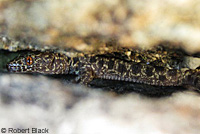 |
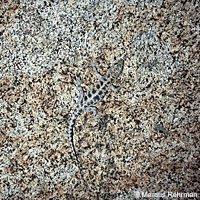 |
| Adult, coastal San Diego County © Paul Maier |
Adult found at 8,740 ft. elevation
(possibly an elevation record) in Riverside County on a mountain that often gets heavy winter snow
© Robert Black |
Adult, San Diego County, well-camouflaged on a granite boulder.
© Marcus Rehrman |
 |
|
|
|
The Night Lizards, genus Xantusia, have small granular scales on soft skin.
Xantusia henshawi is shown here.
|
|
|
|
| |
|
|
|
| Feeding |
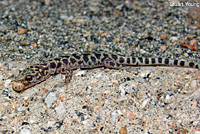 |
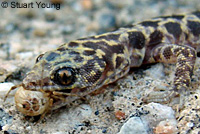 |
|
|
| Night active adult, San Diego County, eating a spider. © Stuart Young |
|
|
| |
|
|
| Habitat |
 |
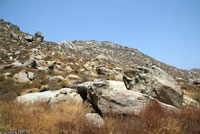 |
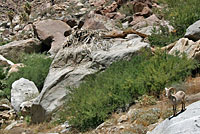 |
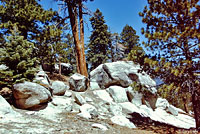 |
| Habitat, Riverside County desert |
Habitat, coastal Riverside County |
Habitat, San Diego County desert |
Habitat, 7,500 ft., San Jacinto
Mountains, Riverside Co. |
 |
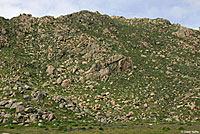 |
 |
 |
Habitat, coastal San Diego County
|
Habitat, coastal Riverside County |
Microhabitat, exfoliated granite under huge boulders, San Diego County |
Habitat, Imperial County |
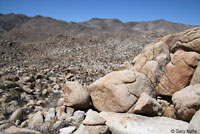 |
 |
 |
 |
| Habitat, Imperial County desert |
Habitat, Imperial County desert |
Habitat, San Diego County
desert mountains |
Habitat, San Diego County
desert mountains |
| |
|
|
|
| Short Videos |
 |
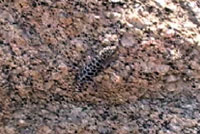 |
|
|
| Granite Night Lizards running around on huge rocks at night. |
Watch a short video of this lizard running in bursts of speed in a serpentine motion.
|
|
|
| |
|
|
|
| Description |
| |
| Size |
2 - 2.75 inches long from snout to vent (5.1 - 7 cm). (Stebbins 2003)
|
| Appearance |
| A small lizard with a flattened body, a flattened head covered with large plates, soft skin with fine granular scales, lidless eyes with vertical pupils, a gular fold, a fold of skin low on each side of the body, and a long thin tail, except when it has been detached and has only partially regenerated. |
| Color and Pattern |
Changes from a dark phase during the day to a light phase at night.
In the light phase the background color is pale with large dark brown spots on the upper surfaces and irregular markings on the tail.
(The light phase is good camouflage that matches the granite rock
surfaces this lizard crawls on at night.)
In the dark phase the background color is dark with a pale white or yellow network on the upper surfaces.
(The dark phase is good camouflage when this lizard hides in dark areas during daylight.)
The underside is whitish with minute black speckling, and is made up of large square scales in 14 lengthwise rows. |
| Male / Female Differences |
Males have enlarged femoral pores and a whitish oval patch on the front edge of the line of femoral pores.
|
| Life History and Behavior |
Activity |
Nocturnal. Comes out of its hiding place after dark, but may also be active at dusk and dawn.
Hides in crevices, under rock flakes and slabs, rarely going out except at night when it can be seen crawling on the face of large rock outcrops and sometimes on cement structures and buildings.
Most active spring through fall, sometimes active on warm winter days.
May be active in crevices during daylight.
Sometimes seen hunting at night on the outside
walls of human structures which are close to rock outcrops, similar to non-native geckos.
Although this lizard prefers similar habitat to the Leaf-toed Gecko, Phyllodactylus xanti, the ranges of these two species rarely overlap and when it does, they almost never share the same microhabitat. |
| Defense |
Wary and secretive. Capable of running quickly for short distances to escape.
The tail can break off easily, but it will grow back.
The detached tail wriggles on the ground which can distract a predator from the body of the lizard allowing it time to escape.
More information about tail loss and regeneration. |
| Diet and Feeding |
| Eats small invertebrates including spiders, scorpions, beetles, ants, and centipedes, and possibly lizard eggs and a small amount of plant material. |
| Reproduction |
Breeds in late spring.
1 - 2 young are born live in the fall.
|
| Habitat |
Inhabits rocky canyons and hillsides in the desert and in semiarid regions, and sometimes coastal sage with no large rock outcrops.
Prefers massive boulders and outcrops with exfoliated granite found in the shadier parts of canyons or near water.
Tends to avoid hotter south-facing slopes.
Vegetation includes chaparral, coastal sage scrub, creosote scrub, woodland, and manzanita and coniferous forest at high elevation locations.
|
| Geographical Range |
Found from the southern side of San Gorgonio Pass, south along the eastern and western slopes of the Peninsular Range, into northern Baja California as far south as the Canon el Cajon divide in the Sierra San Pedro Martir.
Also occurs west of the San Jacinto mountains in the Lake Perris and Lakeview Mountains area.
|
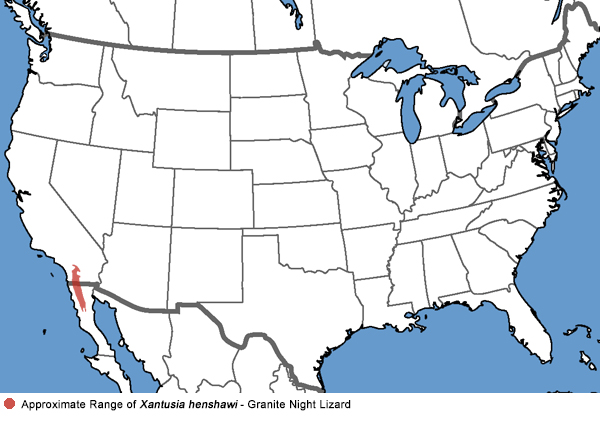 |
| Elevational Range |
Found at elevations of 400 - 8,200 ft. (120 - 2,500 m). (Stebbins 2003 / Jones, Lawrence, Lovich 2009.)
I have also received an unverified report of a lizard seen at 8,500 ft. on Mt. San Jacinto and a verified but unpublished report (as of January 2013) of one found there at 8,740 ft., also, by Robert Black. (Photo shown above.)
|
| Notes on Taxonomy |
Called Xantusia henshawi henshawi - Henshaw's Night Lizard, after the discovery of X. h. gracilis.
It was returned to full species status in 2001 when Lovich (2001 Herpetologica 57(4): 470-487) elevated X. gracilis to a full species.
---------------------------------------------------------------------------------------------------------------------------------------------------------------------
"The standard English name for this clade has been changed (by adding “Northern”), following Bezy (2019, Night Lizards, Eco Herpetological Publishing), to eliminate redundancy with the English name of the clade Xantusiidae."
(Nicholson, K. E. (ed.). 2025 SSAR Scientific and Standard English Names List)
---------------------------------------------------------------------------------------------------------------------------------------------------------------------
Alternate and Previous Names (Synonyms)
Xantusia henshawi henshawi - Henshaw's Night Lizard (Stebbins 2003)
Xantusia henshawi - Granite Night Lizard (Smith 1946, Stebbins 1966, 1985)
Xantusia henshawi - Henshaw Night Lizard (Xantusia picta; Zablepsis heenshawi. Henshaw's Lizard; Cope's Lizard) (Grinnell and Camp 1917)
|
| Conservation Issues (Conservation Status) |
Although common throughout much of its range, this lizard is protected from collection. It needs exfoliated and fissured granite outcrops to survive. It takes thousands of years for this exfoliation and fissuring to occur, so this habitat will not be replaced for many centuries. When flakes and slabs are torn off rock outcrops by someone searching for this lizard or other reptiles, the habitat is irreparably damaged. Such rock destruction is illegal in California: "It is unlawful to use any method or means of collecting that involves breaking apart of rocks, granite flakes, logs or other shelters in or under which reptiles may be found." (2007 regulations 5.60.4.)
Reptile hunters are typically blamed for rock habitat destruction, and there is no doubt they have been destructive, but I have also watched people who were not reptile collectors tearing off huge slabs of granite rock with a crowbar then carrying the slabs back to their truck to haul them away for some other purpose. This law needs to be enforced in ways other than just protecting this species from unscrupulous reptile collectors or there will be no more rocky habitat and no more lizards. |
|
|
Taxonomy |
| Family |
Xantusiidae |
Night Lizards |
Baird, 1858 |
| Genus |
Xantusia |
Northern Night Lizards |
Baird, 1859 “1858” |
Species
|
henshawi |
Granite Night Lizard |
Stejneger, 1893 |
|
Original Description |
Xantusia henshawi - Stejneger, 1893 - Proc. U.S. Natl. Mus., Vol. 16, p. 467
from Original Description Citations for the Reptiles and Amphibians of North America © Ellin Beltz
|
|
Meaning of the Scientific Name |
Xantusia - honors Xantus, John
henshawi - honors Henshaw, Henry W.
from Scientific and Common Names of the Reptiles and Amphibians of North America - Explained © Ellin Beltz
|
|
Related or Similar California Lizards |
X. gracilis - Sandstone Night Lizard
X. vigilis - Yucca Night Lizard
X. sierrae - Sierra Night Lizard
X. r. reticulata - San Clemente Night Lizard
|
|
More Information and References |
California Department of Fish and Wildlife
Robert L. Bezy. Night Lizards: Field Memoirs and a Summary of the Xantusiidae. ECO Herpetological Publishing & Distribution. 2019.
Hansen, Robert W. and Shedd, Jackson D. California Amphibians and Reptiles. (Princeton Field Guides.) Princeton University Press, 2025.
Stebbins, Robert C., and McGinnis, Samuel M. Field Guide to Amphibians and Reptiles of California: Revised Edition (California Natural History Guides) University of California Press, 2012.
Stebbins, Robert C. California Amphibians and Reptiles. The University of California Press, 1972.
Flaxington, William C. Amphibians and Reptiles of California: Field Observations, Distribution, and Natural History. Fieldnotes Press, Anaheim, California, 2021.
Nicholson, K. E. (ed.). 2025. Scientific and Standard English Names of Amphibians and Reptiles of North America North of Mexico, with Comments Regarding Confidence in Our Understanding. Ninth Edition. Society for the Study of Amphibians and Reptiles. [SSAR] 87pp.
Samuel M. McGinnis and Robert C. Stebbins. Peterson Field Guide to Western Reptiles & Amphibians. 4th Edition. Houghton Mifflin Harcourt Publishing Company, 2018.
Stebbins, Robert C. A Field Guide to Western Reptiles and Amphibians. 3rd Edition. Houghton Mifflin Company, 2003.
Behler, John L., and F. Wayne King. The Audubon Society Field Guide to North American Reptiles and Amphibians. Alfred A. Knopf, 1992.
Robert Powell, Roger Conant, and Joseph T. Collins. Peterson Field Guide to Reptiles and Amphibians of Eastern and Central North America. Fourth Edition. Houghton Mifflin Harcourt, 2016.
Powell, Robert., Joseph T. Collins, and Errol D. Hooper Jr. A Key to Amphibians and Reptiles of the Continental United States and Canada. The University Press of Kansas, 1998.
Bartlett, R. D. & Patricia P. Bartlett. Guide and Reference to the Turtles and Lizards of Western North America (North of Mexico) and Hawaii. University Press of Florida, 2009.
Jones, Lawrence, Rob Lovich, editors. Lizards of the American Southwest: A Photographic Field Guide. Rio Nuevo Publishers, 2009.
Smith, Hobart M. Handbook of Lizards, Lizards of the United States and of Canada. Cornell University Press, 1946.
Taylor, Emily. California Lizards and How to Find Them. Heyday, Berkeley, California. 2025.
Grismer, L. Lee. Amphibians and Reptiles of Baja California, Including Its Pacific Islands and the Islands in the Sea of Cortés. The University of California Press, 2002.
McPeak, Ron H. Amphibians and Reptiles of Baja California. Sea Challengers, 2000.
Samuel M. McGinnis and Robert C. Stebbins. Peterson Field Guide to Western Reptiles & Amphibians. 4th Edition. Houghton Mifflin Harcourt Publishing Company, 2018.
Stebbins, Robert C. A Field Guide to Western Reptiles and Amphibians. 3rd Edition. Houghton Mifflin Company, 2003.
The Reptile Database
Lemm, Jeffrey. Field Guide to Amphibians and Reptiles of the San Diego Region (California Natural History Guides). University of California Press, 2006.
Joseph Grinnell and Charles Lewis Camp. A Distributional List of the Amphibians and Reptiles of California. University of California Publications in Zoology Vol. 17, No. 10, pp. 127-208. July 11, 1917.
|
|
|
The following conservation status listings for this animal are taken from the April 2024 State of California Special Animals List and the April 2024 Federally Listed Endangered and Threatened Animals of California list (unless indicated otherwise below.) Both lists are produced by multiple agencies every year, and sometimes more than once per year, so the conservation status listing information found below might not be from the most recent lists. To make sure you are seeing the most recent listings, go to this California Department of Fish and Wildlife web page where you can search for and download both lists:
https://www.wildlife.ca.gov/Data/CNDDB/Plants-and-Animals.
A detailed explanation of the meaning of the status listing symbols can be found at the beginning of the two lists. For quick reference, I have included them on my Special Status Information page.
If no status is listed here, the animal is not included on either list. This most likely indicates that there are no serious conservation concerns for the animal. To find out more about an animal's status you can also go to the NatureServe and IUCN websites to check their rankings.
Check the current California Department of Fish and Wildlife sport fishing regulations to find out if this animal can be legally pursued and handled or collected with possession of a current fishing license. You can also look at the summary of the sport fishing regulations as they apply only to reptiles and amphibians that has been made for this website.
This animal is not included on the Special Animals List, which indicates that there are no significant conservation concerns for it in California, however, it is protected from collection in order to preserve its rocky habitat.
|
| Organization |
Status Listing |
Notes |
| NatureServe Global Ranking |
G4 |
Apparently Secure (2/21) |
| NatureServe State Ranking |
|
|
| U.S. Endangered Species Act (ESA) |
None |
|
| California Endangered Species Act (CESA) |
None |
|
| California Department of Fish and Wildlife |
None |
|
| Bureau of Land Management |
None |
|
| USDA Forest Service |
None |
|
| IUCN |
|
|
|
|















































